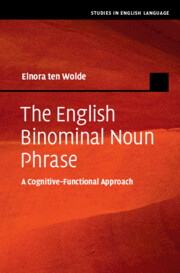Book contents
- The English Binominal Noun Phrase
- Studies in English Language
- The English Binominal Noun Phrase
- Copyright page
- Dedication
- Contents
- Figures
- Tables
- Acknowledgments
- Abbreviations
- Chapter 1 Introduction
- Part I Categorization
- Part II Testing the Hypothesis
- Part III Theoretical Analysis
- Part IV Discussion
- Chapter 10 Discussion and Conclusions
- References
- Index
Chapter 10 - Discussion and Conclusions
from Part IV - Discussion
Published online by Cambridge University Press: 29 June 2023
- The English Binominal Noun Phrase
- Studies in English Language
- The English Binominal Noun Phrase
- Copyright page
- Dedication
- Contents
- Figures
- Tables
- Acknowledgments
- Abbreviations
- Chapter 1 Introduction
- Part I Categorization
- Part II Testing the Hypothesis
- Part III Theoretical Analysis
- Part IV Discussion
- Chapter 10 Discussion and Conclusions
- References
- Index
Summary
The final chapter briefly summarizes the key findings in Parts I and II and compares and discusses the strengths and weaknesses of the models discussed in Chapters 8 and 9. In particular, it is argued that one of the fundamental differences between these two approaches is the information they seek to model. FDG offers defined primitives and combinatorial constraints that function as a basis of analysis and constrain possible outcomes. In the context of this project, this means that FDG allows us to capture the distinction between the six of-binominal categories discussed by using the language-specific tools that already exist in the model. However, the FDG account lacks a network view of these phenomena. The CxG analysis offers a network perspective on the changes in constructions and links these constructions to more entrenched patterns in the language systems. This means that it can capture the co-evolution of constructions in the language system. Finally, this chapter discusses some remaining open questions and suggests potential avenues of future research.
Keywords
- Type
- Chapter
- Information
- The English Binominal Noun PhraseA Cognitive-Functional Approach, pp. 277 - 285Publisher: Cambridge University PressPrint publication year: 2023

